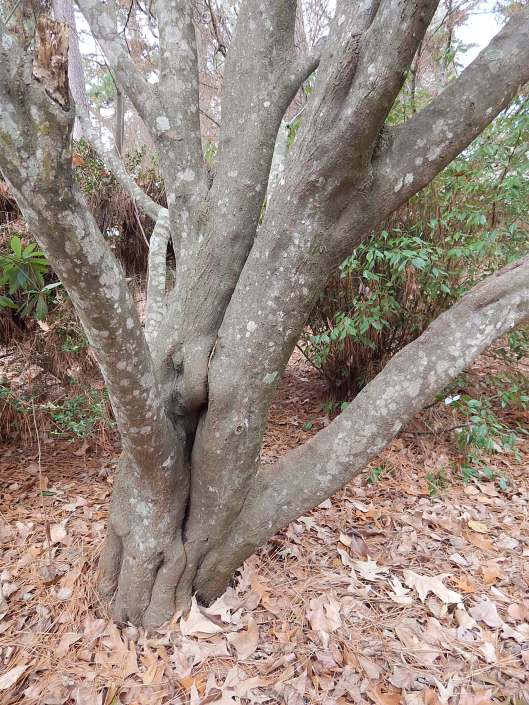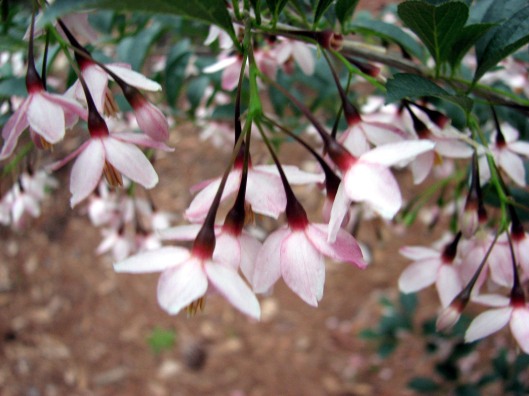Styrax japonica ‘Emerald Pagoda’ is no doubt one of JC Raulston’s greatest introductions, one of those special landscape plants that deserve more use in the south. Planted in 1988, our oldest specimen sports a heavy bloom about mid-April and is a spectacle for several weeks. This particular clone is unique and different from other Japanese snowbells and their cousins.

Styrax japonica ‘Emerald Pagoda’ in bloom
The leaves and blooms are larger and growth habit is distinctly pyramidal to conical by nature in our region. We have noted in some years (this one included) what we believe might be a slight problem with inadequate chilling – tufted early season growth, delayed foliation and stretches of healthy buds that insist on remaining dormant for a longer period of time – but the verdict is mixed on that. Some Houston plants are reported to perform fine. Our Zone 8A/B location and a mild winter may define this clone’s southern range? At any rate, more evidence is needed in our region and proper seedling selection appears prudent.
This plant had a precarious early life during its trek into commerce. J.C. Raulston’s “Friends of the NCSU Arboretum” Newsletter Number 18, December 1987, chronicles the National Arboretum’s 1985 Korean expedition – and the one-day visit to the small island of Sohuksan off the coast of Korea. The exact history of this clone was not included and as I remember JC’s recount, he was waiting at the docks for the ferry and the day-long return trip to the mainland, brooding over a particular styrax he had seen near the top of the mountain. At the last moment he made the decision to grab some cuttings. He raced to the top of the mountain, mist and rain making the trail even more challenging, made the collection, and raced back to the dock arriving just in the nick of time to jump on the ferry. The wrapped, moistened cuttings were held two days before shipped by air to Raleigh – and the cuttings arrived sadly wilted. Technician Newell Hancock immediately placed them into the mist chamber. The leaves dropped. An on-the-spot decision was made to graft the cuttings to Styrax japonica seedlings. One survived. That specimen was nurtured for several months (spring 1986) and made good growth despite one mishap; a student assistant accidentally dragged a hose across the bench and knocked the graft askew. A sliver of wood and cambium lay connected. Technician Hancock spliced it back together, wrapped the wound and placed the budling in the mist chamber for a few days. The graft survived. From that plant and that history, thousands now grace southern and east coast landscapes. We received our first plant in 1988; it was grown one year in the shade house before planting into the SFA Arboretum’s “Asian Valley.” It has grown into one of the largest in the nation. ‘Emerald Pagoda’ is unique and different from other Japanese snowbells and their cousins. The leaves and blooms are larger and growth habit is distinctly pyramidal to conical by nature in our region.

The oldest ‘Emerald Pagoda’ is in the SFA Mast Arboretum
Styrax japonica is native to China, Japan and Korea. Japanese snowbells commonly grow to twenty to thirty feet and a number of cultivars are available. Bell-shaped flowers hang in mass from beneath the branches and the tree is best viewed from below. ‘Pink Chimes’ has a nice habit and, for us, enjoys a bleached light pink flower. This year’s show is better than past, perhaps because of the cool spring we have been having after a mild winter. ‘Carillon’ has a distinct weeping habit and has been a very slow grower in the Arboretum. ‘Fargesii is reported to have a robust tree-like habit. In Japan, ‘Benibana’ is the name referred to pink-flowered seed-raised forms. While Japanese snowbells appreciate moist, well-drained soils they also appear to perform well in heavier soils in the Arboretum. After two or three years of establishment, the trees are quite tough. Other Styrax species in the SFA Arboretum include Styrax americanum, S. americanum var. pulverlentum, S. grandifolium, S. texana, S. hemsleyanum, S. obassia, and S. philadelphoides, S. formasanum, S. serrulatum, S. calvescens, S. tonkinensis and a few others.
One interesting side note. I grafted S. japonica ‘rubrum pendula’ on an ‘Emerald Pagoda’ rootstock years ago. While the graft took and the tree still lives in the Ruby Mize Garden, the graft shows signs of incompatibility. That is the rootstock is of smaller diameter than the scion variety. We have also obsereved that the blooms are pinker than our large ‘rubrum pendula’ on its own roots which produces blooms that are closer to a very pale pink to cream color. Perhaps the incompatibility is the reason for the blooms being pinker?

Styrax japonica ‘rubrum pendula’ grafted on to ‘Emerald Pagoda’ rootstock
Our original specimen of S. japonica ‘Emerald Pagoda’ arrived as one of those JC Raulston’s “I-can’t-believe-it’s-Christmas” boxes. Gifts like that made the early years in this Arboretum so much fun. The NCSU Arboretum, now the JC Raulston Arboretum, made a name for itself by spreading plant wealth near and far. The SFA Arboretum ended up being a part of that excitement. With a modicum of good horticulture, our garden is now blessed with many pearls of plant life worth appreciating as we trek through this life of adventuresome gardening.




